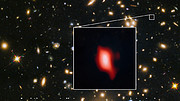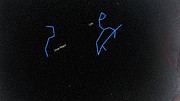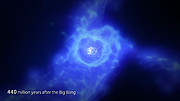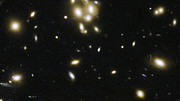Galaxy cluster MACS j1149.5+223
ALMA observation of distant galaxy MACS 1149-JD1
Videos




ESOcast 161 Light: Distant galaxy reveals very early star formation (4K UHD)

Zooming in on the distant galaxy MACS1149, and beyond

Computer simulation of star formation in MACS1149-JD1
Zooming in on the distant galaxy MACS 1149-JD1
More Information
Contacts:
Astronomers have used observations from
the Atacama Large Millimeter/submillimeter Array (ALMA) and ESO’s Very
Large Telescope (VLT) to determine that star formation in the very
distant galaxy MACS1149-JD1 started at an unexpectedly early stage, only
250 million years after the Big Bang. This discovery also represents
the most distant oxygen ever detected in the Universe and the most
distant galaxy ever observed by ALMA or the VLT. The results will appear
in the journal Nature on 17 May 2018.
An international team of astronomers used ALMA
to observe a distant galaxy called MACS1149-JD1. They detected a very
faint glow emitted by ionised oxygen in the galaxy. As this infrared
light travelled across space, the expansion of the Universe stretched it
to wavelengths more than ten times longer by the time it reached Earth
and was detected by ALMA. The team inferred that the signal was emitted
13.3 billion years ago (or 500 million years after the Big Bang), making
it the most distant oxygen ever detected by any telescope [1]. The presence of oxygen is a clear sign that there must have been even earlier generations of stars in this galaxy.
“I was thrilled to see the signal of the distant oxygen in the ALMA data,” says Takuya Hashimoto, the lead author of the new paper and a researcher at both Osaka Sangyo University and the National Astronomical Observatory of Japan. “This detection pushes back the frontiers of the observable Universe.”
In addition to the glow from oxygen picked up by ALMA, a weaker signal of hydrogen emission was also detected by ESO’s Very Large Telescope
(VLT). The distance to the galaxy determined from this observation is
consistent with the distance from the oxygen observation. This makes
MACS1149-JD1 the most distant galaxy with a precise distance measurement
and the most distant galaxy ever observed with ALMA or the VLT.
“This galaxy is seen at a time when the Universe was only 500
million years old and yet it already has a population of mature stars,” explains Nicolas Laporte, a researcher at University College London (UCL) in the UK and second author of the new paper. “We are therefore able to use this galaxy to probe into an earlier, completely uncharted period of cosmic history.”
For a period after the Big Bang there was no oxygen in the Universe;
it was created by the fusion processes of the first stars and then
released when these stars died. The detection of oxygen in MACS1149-JD1
indicates that these earlier generations of stars had been already
formed and expelled oxygen by just 500 million years after the beginning
of the Universe.
But when did this earlier star formation occur? To find out, the team
reconstructed the earlier history of MACS1149-JD1 using infrared data
taken with the NASA/ESA Hubble Space Telescope and the NASA Spitzer Space Telescope.
They found that the observed brightness of the galaxy is well-explained
by a model where the onset of star formation corresponds to only 250
million years after the Universe began [2].
The maturity of the stars seen in MACS1149-JD1 raises the question of
when the very first galaxies emerged from total darkness, an epoch
astronomers romantically term “cosmic dawn”. By establishing the age of
MACS1149-JD1, the team has effectively demonstrated that galaxies
existed earlier than those we can currently directly detect.
Richard Ellis, senior astronomer at UCL and co-author of the paper, concludes: “Determining
when cosmic dawn occurred is akin to the Holy Grail of cosmology and
galaxy formation. With these new observations of MACS1149-JD1 we are
getting closer to directly witnessing the birth of starlight! Since we
are all made of processed stellar material, this is really finding our
own origins.”
More Information
These results are published in a paper entitled: “The onset of star
formation 250 million years after the Big Bang”, by T. Hashimoto et al.,
to appear in the journal Nature on 17 May 2018.
The research team members are: Takuya Hashimoto (Osaka Sangyo
University/National Astronomical Observatory of Japan, Japan), Nicolas
Laporte (University College London, United Kingdom), Ken Mawatari (Osaka
Sangyo University, Japan), Richard S. Ellis (University College London,
United Kingdom), Akio. K. Inoue (Osaka Sangyo University, Japan), Erik
Zackrisson (Uppsala University, Sweden), Guido Roberts-Borsani
(University College London, United Kingdom), Wei Zheng (Johns Hopkins
University, Baltimore, Maryland, United States), Yoichi Tamura (Nagoya
University, Japan), Franz E. Bauer (Pontificia Universidad Católica de
Chile, Santiago, Chile), Thomas Fletcher (University College London,
United Kingdom), Yuichi Harikane (The University of Tokyo, Japan), Bunyo
Hatsukade (The University of Tokyo, Japan), Natsuki H. Hayatsu (The
University of Tokyo, Japan; ESO, Garching, Germany), Yuichi Matsuda
(National Astronomical Observatory of Japan/SOKENDAI, Japan), Hiroshi
Matsuo (National Astronomical Observatory of Japan/SOKENDAI, Japan,
Sapporo, Japan), Takashi Okamoto (Hokkaido University, Sapporo, Japan),
Masami Ouchi (The University of Tokyo, Japan), Roser Pelló (Université
de Toulouse, France), Claes-Erik Rydberg (Universität Heidelberg,
Germany), Ikkoh Shimizu (Osaka University, Japan), Yoshiaki Taniguchi
(The Open University of Japan, Chiba, Japan), Hideki Umehata (The
University of Tokyo, Japan) and Naoki Yoshida (The University of Tokyo,
Japan).
ESO is the foremost intergovernmental astronomy organisation in
Europe and the world’s most productive ground-based astronomical
observatory by far. It has 15 Member States: Austria, Belgium, the Czech
Republic, Denmark, France, Finland, Germany, Italy, the Netherlands,
Poland, Portugal, Spain, Sweden, Switzerland and the United Kingdom,
along with the host state of Chile and with Australia as a strategic
partner. ESO carries out an ambitious programme focused on the design,
construction and operation of powerful ground-based observing facilities
enabling astronomers to make important scientific discoveries. ESO also
plays a leading role in promoting and organising cooperation in
astronomical research. ESO operates three unique world-class observing
sites in Chile: La Silla, Paranal and Chajnantor. At Paranal, ESO
operates the Very Large Telescope and its world-leading Very Large
Telescope Interferometer as well as two survey telescopes, VISTA working
in the infrared and the visible-light VLT Survey Telescope. ESO is also
a major partner in two facilities on Chajnantor, APEX and ALMA, the
largest astronomical project in existence. And on Cerro Armazones, close
to Paranal, ESO is building the 39-metre Extremely Large Telescope, the
ELT, which will become “the world’s biggest eye on the sky”.
Links
Links
Contacts:
Nicolas Laporte
University College London
London, United Kingdom
Tel: +44 7452 807 591
Email: n.laporte@ucl.ac.uk
Richard Ellis
University College London
London, United Kingdom
Tel: +44 7885 403 334
Email: richard.ellis@ucl.ac.uk
Richard Hook
ESO Public Information Officer
Garching bei München, Germany
Tel: +49 89 3200 6655
Cell: +49 151 1537 3591
Email: pio@eso.org



